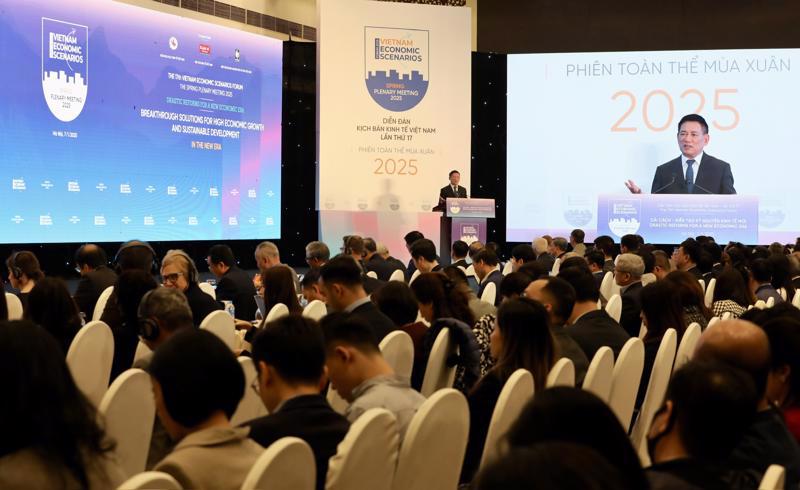The world will witness a pivotal moment in just a few weeks, as US President Donald Trump officially embarks on his second term in office, marking the dawn of the “Trump 2.0” era. This shift is expected to set the stage for a series of economic and geopolitical changes.
At the 17th Vietnam Economic Scenarios Forum: Spring Plenary Meeting 2025, with the theme “Drastic Reforms for a New Economic Era”, Mr. Suan Teck Kin, Head of Research and Executive Director, Global Economics and Markets Research, at United Overseas Bank (UOB), offered a valuable perspective on the potential implications of President Trump’s second term for Vietnam. While the Trump 2.0 era may bring disruption and uncertainty, it also opens doors for Vietnam to seize new opportunities for growth and resilience. As the US continues to redefine its role on the global stage, Vietnam’s economy will need to adapt and innovate to capitalize on the emerging trends while navigating the complexities of an increasingly interconnected world.
Three challenges
Challenge 1: Tariff threats mean market and supply diversification will be key for most export-oriented economies
Tariff threats have become a critical challenge for export-driven economies, especially those like Vietnam, where trade is a cornerstone of economic growth. Boasting the second-highest economic growth rate in ASEAN, after Singapore, Vietnam is highly dependent upon international trade. In 2024, its GDP growth came in at 7.09 per cent, driven largely by exports and international trade. This reliance puts Vietnam at risk, particularly as tariff policies under the Trump administration could disrupt existing market dynamics.
Vietnam actually benefited from Trump’s first tariff shift, but its position remains precarious and further tariff increases could jeopardize its growth. As Mr. Suan emphasized, there is a clear need for diversification. “How can we manage the risk from these tariff threats?” he asked. This question underscores the necessity for businesses to rethink their approach to both market and supply chain dependencies.
Diversifying trade markets is essential to reducing reliance on key regions like the US and China. Mr. Suan suggested that economies like Vietnam could look to sell more to Southeast Asia, the EU, and other markets, reducing its vulnerability to external trade shifts. Similarly, supply chain diversification, by spreading procurement and manufacturing across different regions, helps mitigate the risks of potential disruptions. This, in turn, strengthens businesses’ resilience to tariff threats and global uncertainties.
Challenge 2: Financial market risks - US dollar and foreign exchange volatility driven by US trade policies and geopolitical uncertainties
Financial market volatility, particularly in exchange rates, presents a significant challenge in the current global environment, influenced heavily by US trade policies and geopolitical uncertainties. “In Trump 1.0, this involved the Chinese currency,” Mr. Suan said, with most currencies, including the VND, moving in tandem with the Chinese yuan.
Vietnam is better positioned relatively-speaking due to controlled management by the State Bank of Vietnam (SBV), given that it manages such fluctuations carefully to avoid extreme depreciation. However, while Vietnam may not face the same level of depreciation pressure, its trading partners could experience significant currency pressures if the yuan or other currencies continue to decline.
The US dollar’s strength is also a key factor, and the expectation is for it to continue strengthening until at least mid-year. “We expect the US dollar to move higher and be stronger until at least the middle part of this year,” he highlighted in his address. This presents a risk for export-dependent economies like Vietnam, as a stronger US dollar could lead to increased costs for businesses reliant upon foreign currencies, especially when it comes to imports and international transactions.
Challenge 3: Will supply chain shifts continue to favor ASEAN?
The shifting dynamics of global supply chains present a crucial challenge, especially for economies like ASEAN, which have become significant beneficiaries of these changes. ASEAN has emerged as the Number 2 FDI destination in the world, following the US and even surpassing China. In 2023, FDI inflows to ASEAN reached a record $226 billion, reflecting the growing importance of the region in global trade. This trend is driven by the ongoing globalization and trade pattern changes, with Vietnam, for example, seeing very strong FDI inflows.
The key question, however, is whether this trend will continue. As Mr. Suan asked, “If reshoring in the US continues to happen, what is likely to impact this supply chain?” This reshoring trend, driven by US trade policy, could alter the flow of FDI into ASEAN and potentially reduce its dominance in global supply chains. It remains uncertain whether this shift will continue to favor ASEAN or if the region will face challenges due to geopolitical uncertainties.
However, as long as Vietnam and other ASEAN countries maintain their competitive edge, they will likely continue to attract significant FDI. “If Vietnam continues to stay competitive, it will be able to address these issues and continue to attract more investment,” he emphasized. Vietnam has experienced strong momentum in FDI, with inflows remaining robust even as the global trade environment becomes more complex.
Three opportunities
Opportunity 1: Trade diversification to reduce risk of over-dependence
Vietnam has a strong dependence on both the US and China, which has led to significant trade exposure; a situation that underscores the risk of focusing too heavily on these two markets. Businesses in Vietnam should consider expanding their sales to other countries, not just relying on the US, which can create instability if market conditions change unexpectedly. A key strategy here is to explore markets in Europe. The country has an existing free trade agreement (FTA) with the EU, opening up opportunities for diversification.
In addition to market diversification, Vietnam should also consider broadening the scope of the products it exports. At present, its exports are largely concentrated in electronics and IT-related goods, such as mobile phones and machinery components. This narrow focus presents risks if demand for these products falters. The government and business associations have a role to play here. They can help facilitate connections with other markets, encouraging the export of products like agriculture, which could serve as a strong alternative. “How can we in Vietnam expand our products to other countries?” he asked. “The government can play a part in export promotion, and business associations can help link up with other countries.” A diversified product offering will better shield Vietnam from global market volatility and help secure more stable, long-term growth.
Opportunity 2: Domestic infrastructure investment to help mitigate external risks and strengthen future competitiveness
The second opportunity lies in investing in domestic infrastructure, which is crucial for mitigating external risks and enhancing competitiveness in the global market. As Mr. Suan noted, infrastructure investment is a critical area for Vietnam to focus on, particularly in the face of external challenges.
To remain competitive, it must increase its capital formation and focus on productivity improvements through infrastructure development. “Increasing investment will help increase productivity, reduce costs, and attract more foreign investment,” he believes. Investments in key sectors such as transportation, energy, and urban development will not only improve the business environment but also provide a cushion against the volatility caused by external geopolitical risks. Further development of infrastructure will facilitate greater economic integration, reduce logistical costs, and make Vietnam a more attractive destination for global investors, all of which are essential for its continued competitiveness in the global marketplace.
Opportunity 3: Fiscal support should play an important role
The third opportunity centers on fiscal support, which plays a crucial role in Vietnam’s economic development. Vietnam’s public debt is notably lower compared to other emerging markets. It is quite disciplined in its budget, with the government paying down debt and not spending as much, so public debt is projected to continue to fall. This fiscal discipline has created significant space for the government to increase spending on strategic investments, particularly in infrastructure, education, and innovation, all of which will be critical for long-term growth.
Mr. Suan emphasized that there is a lot of room for the Vietnamese Government to increase its spending and participation in investment. With a strong fiscal position, it can play a vital role in steering the economy toward sustainable growth. This includes ensuring that investments are strategically focused on long-term objectives, such as fostering innovation and upgrading workforce skills. Additionally, government spending can help smooth out the cyclical fluctuations that often characterize global markets and provide businesses with a more stable environment in which to operate. This targeted fiscal support will not only benefit the economy in the short term but also position Vietnam for future growth, helping it compete with other emerging markets.









 Google translate
Google translate